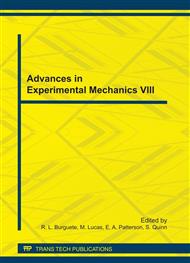p.171
p.177
p.183
p.189
p.195
p.201
p.207
p.213
p.219
Experimental and Numerical Characterization of the Impact Response of Polyethylene Sandwich Panel: A Preliminary Study
Abstract:
The present work present a preliminary study to evaluate the impact response of a new sandwich panel, made up of two polyethylene skins separated by lightweight polyethylene foam. An impact test campaign was conducted on 15 square specimens (side 100 mm, total height 44 mm, average skins height 2.75 mm) with not macroscopic defects, obtained by three homogenous panels. The absorbed energy, the force and the crosshead velocity were recorded during the test. Three level of impact energy were considered. Experimental tests have allowed to obtain the impact energy/acceleration and the peak stress/impact energy diagrams for this material. Moreover, the specimen profile of the section that passes through the impact area was obtained before the test, just after the impact and one hour later for each specimen. Subsequently the experiment was reproduced by means of solid explicit finite element (FE) model in Abaqus. In order to simulate as real as possible the panel behaviour, the skins were modelled as elasto-plastic material while the core was simulated as elastomeric hyperfoam material. The material constants were based on previous experimental data conducted on the same material. After the FEM model validation, the stress-strain resulting maps were plotted.
Info:
Periodical:
Pages:
195-200
Citation:
Online since:
August 2011
Authors:
Price:
Сopyright:
© 2011 Trans Tech Publications Ltd. All Rights Reserved
Share:
Citation:


